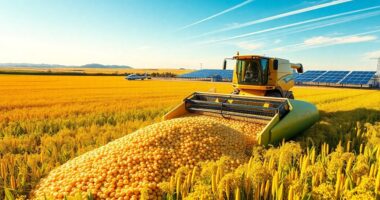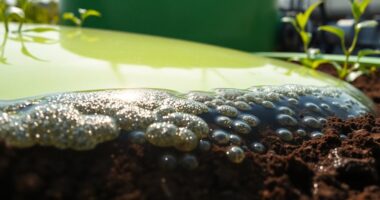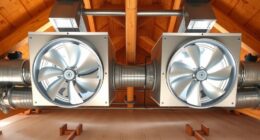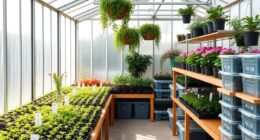Using solar power in your greenhouse can drastically cut energy costs and boost your crop yields. By harnessing sunlight, you create an optimal environment for plant growth while reducing your carbon footprint. Solar panels provide electricity for vital operations, ensuring efficiency and independence from the grid. Plus, with government incentives and advancing technology, it’s an increasingly viable option. If you want to discover more about maximizing your greenhouse’s potential, there’s plenty more to explore.
Key Takeaways
- Solar-powered greenhouses use photovoltaic panels to convert sunlight into electricity, ensuring a consistent power supply for essential systems.
- Efficient sunlight capture and optimal orientation maximize plant growth while reducing energy costs and carbon footprints.
- Incorporating thermal mass solutions, like water barrels, helps store heat for temperature regulation during colder periods.
- Government incentives, such as tax credits and net metering, can significantly offset the initial investment for solar systems.
- Using smart technologies for monitoring can enhance productivity and optimize the greenhouse environment effectively.
Benefits of Solar-Powered Greenhouses
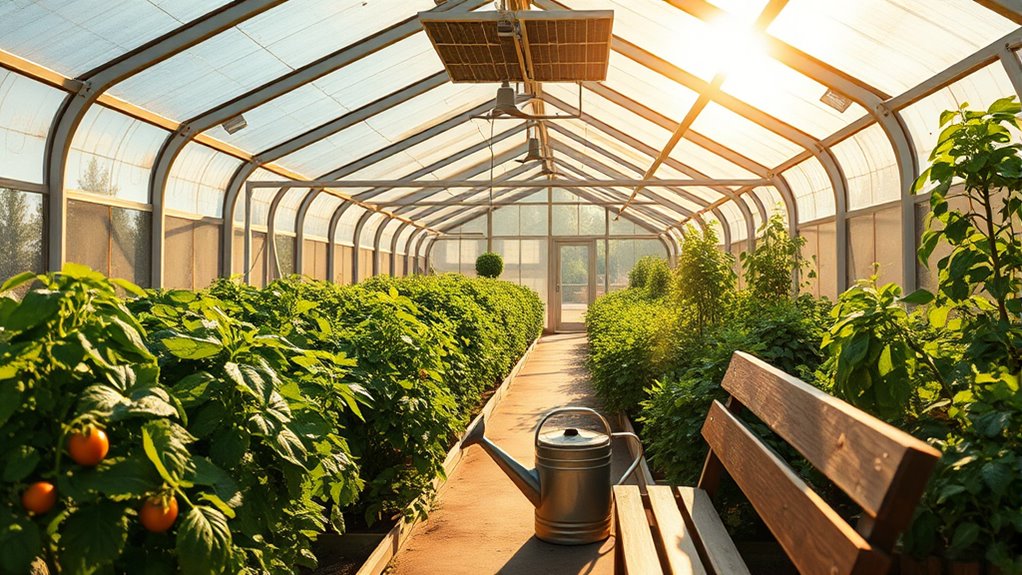
As you explore the benefits of solar-powered greenhouses, you’ll discover that they offer significant advantages for both your wallet and the environment.
First, these greenhouses drastically reduce energy costs by harnessing renewable solar energy, leading to lower operating expenses and long-term savings. You’ll also enjoy energy independence, as solar power lets you operate off the grid. Additionally, using chia seeds in weight loss can help support your health as you grow your own produce in a sustainable way. Moreover, the use of solar energy in greenhouses not only enhances crop yields but also improves overall efficiency in food production. By employing battery-less solar inverters, you can maximize energy use directly from solar panels, further reducing costs. Furthermore, these practices contribute to biodiversity conservation, helping to protect diverse ecosystems and species.
Solar greenhouses cut energy costs and enhance energy independence, allowing you to thrive off the grid.
Environmentally, solar greenhouses help minimize your carbon footprint by using clean energy, promoting sustainable agriculture, and conserving vital resources like water. Additionally, incorporating advanced filtration systems can further enhance indoor air quality, creating healthier growing conditions for your plants.
With reduced pollution and eco-friendly operations, you’ll align your practices with global sustainability goals.
How Solar-Powered Greenhouses Operate
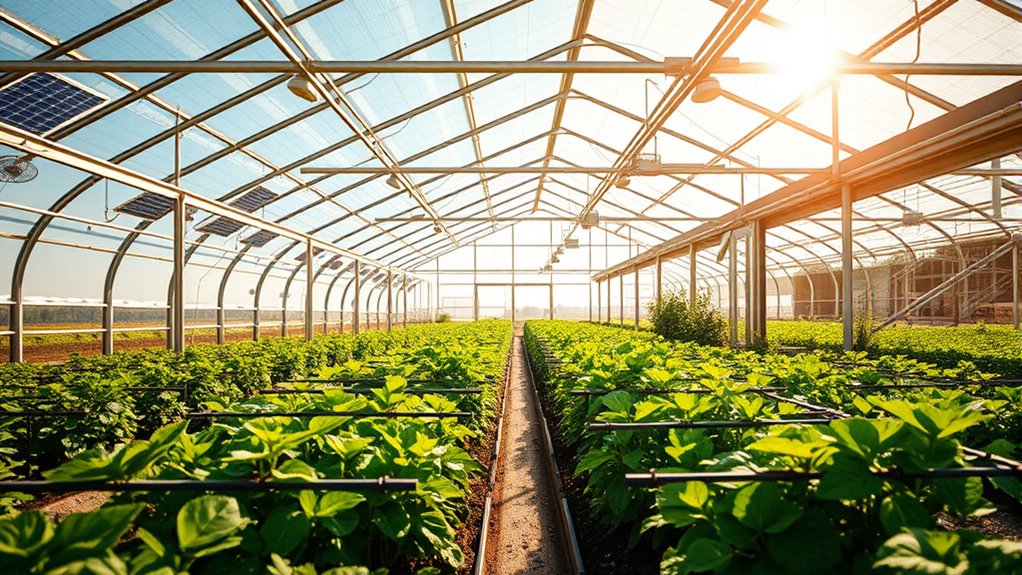
Solar-powered greenhouses operate by efficiently harnessing sunlight to create an optimal environment for plant growth. Typically, you’ll find them oriented south to maximize sunlight exposure, with insulated north-facing walls to minimize heat loss.
Glazing materials, like glass or polycarbonate panels, allow sunlight in while maintaining warmth. Natural ventilation systems help regulate temperature, ensuring comfort for your plants during varying seasons.
Photovoltaic panels convert sunlight into electricity, powering essential systems such as lighting and heating. You’ll appreciate solar generators, which store excess energy for use on cloudy days or at night.
With careful design and efficient systems, solar-powered greenhouses not only thrive but also promise lower operational costs and increased sustainability throughout the year.
Environmental Impact of Solar Energy

While many celebrate the advantages of solar energy, it’s essential to recognize its environmental impact as well.
Solar power is a renewable resource that reduces reliance on finite fossil fuels, helping combat climate change. By generating electricity without releasing greenhouse gases, it contributes to cleaner air. Plus, solar panels use minimal water compared to traditional power plants, conserving this precious resource.
However, large solar farms can disrupt ecosystems and require careful land management. Solar panels also contain hazardous materials that need proper handling to avoid contamination.
Despite these challenges, the solar industry creates jobs and supports local economies, making it a significant player in the shift toward sustainable energy. Embracing solar energy means making informed choices for a healthier planet.
Challenges and Limitations of Solar-Powered Greenhouses
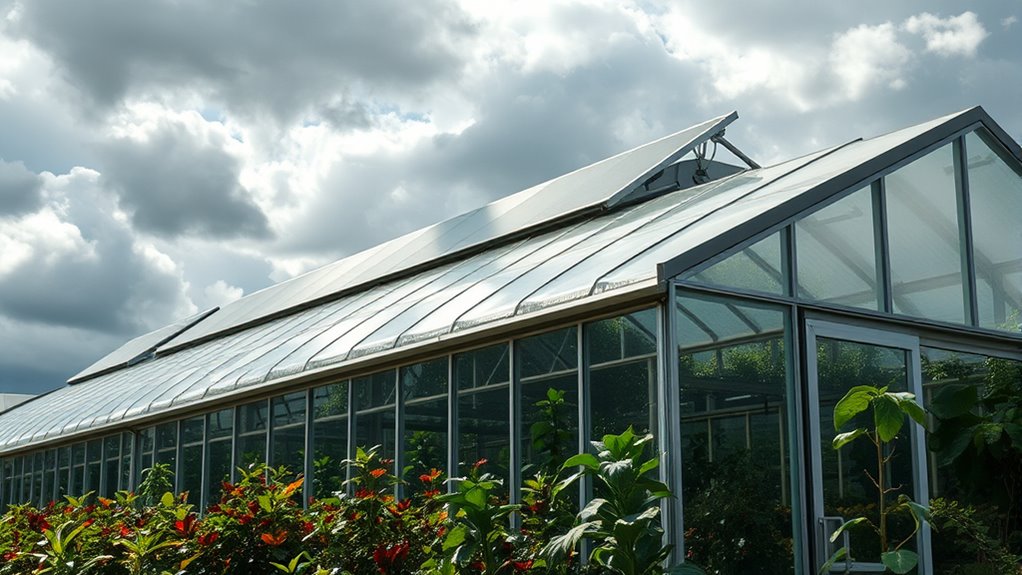
Embracing solar energy in greenhouses offers numerous advantages, but it’s important to consider the challenges and limitations that come with this technology.
First, the high upfront costs of solar panels and advanced equipment can be daunting, especially for small-scale farmers.
You’ll need technical know-how to manage the complex systems and perform regular maintenance, which often requires specialized skills.
Additionally, the design and orientation of your greenhouse must optimize solar capture, limiting flexibility and requiring more space.
Energy production can be inconsistent due to weather variability, making it necessary to invest in storage solutions.
Lastly, geographical and climate factors can further impact the effectiveness of solar-powered greenhouses, especially in areas with limited sunlight.
Enhancing Crop Yield and Quality

By harnessing the power of solar energy, you can create an optimal environment for your crops, significantly enhancing both yield and quality.
Solar-powered greenhouses maintain ideal temperature, humidity, and light levels, leading to healthier plants and increased productivity. You’ll enjoy year-round production, even in less favorable climates, while reducing pests and diseases thanks to controlled conditions.
By optimizing supplemental lighting, you can fine-tune plant growth and flowering cycles, boosting yields further. The stable environment also allows for better management of plant development, resulting in higher-quality crops.
Moreover, with reduced reliance on pesticides, your harvests can be cleaner and more nutritious, giving you the satisfaction of growing not just more, but better food.
Extending the Growing Season With Solar Power
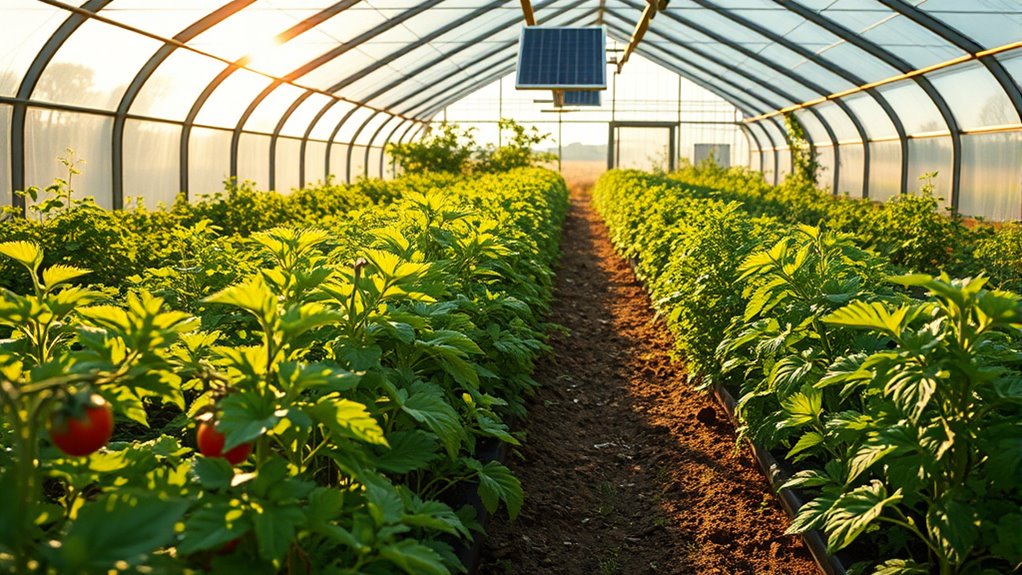
Solar power not only enhances crop yield and quality but also plays a pivotal role in extending the growing season.
With solar-powered greenhouses, you can maintain constant temperatures and lighting conditions, enabling year-round production. These controlled environments allow you to cultivate crops during less-than-ideal weather, minimizing your reliance on external conditions.
Harness solar-powered greenhouses for consistent temperatures and lighting, ensuring year-round crop production regardless of weather conditions.
By utilizing solar panels for heating and supplemental lighting, you can optimize growing conditions even in low-light scenarios. Plus, the flexibility of location means you can set up your solar greenhouse in urban or rural settings.
This innovation not only boosts your crop variety but also strengthens food security and supports local economies by reducing dependency on imports.
Embrace solar power to maximize your growing potential!
Energy Efficiency and Cost Savings
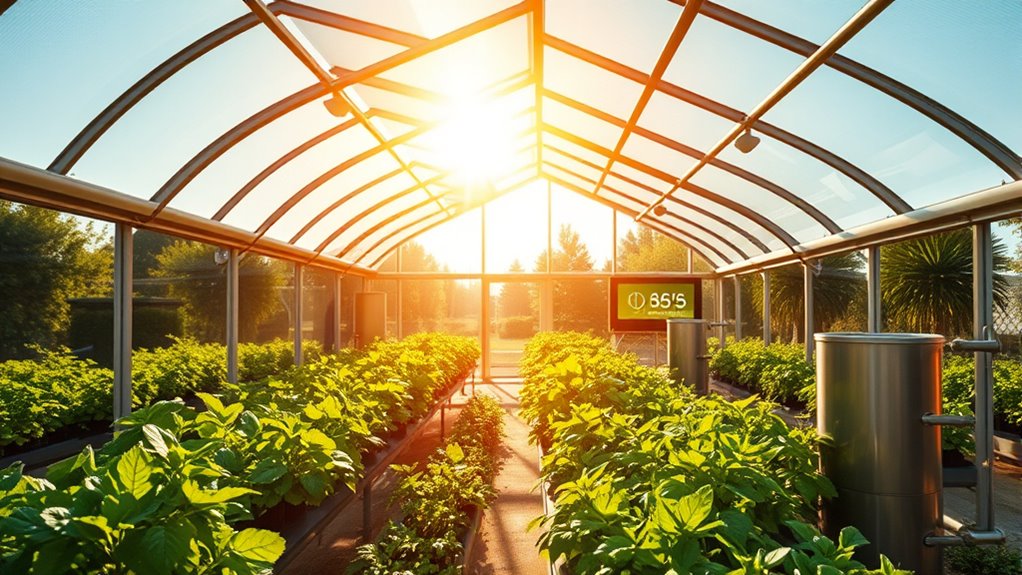
Investing in solar-powered greenhouses not only promotes sustainability but also delivers significant energy efficiency and cost savings. By harnessing renewable solar energy, you reduce reliance on fossil fuels and cut down on energy bills. Advanced climate control systems help you optimize temperature and humidity, while proper insulation and ventilation minimize heat loss. Automated systems further enhance efficiency by managing resources intelligently. Additionally, incorporating commercial grade heat pumps can significantly reduce energy costs and improve operational efficiency. Plus, using thermal mass materials like stone walls and water barrels helps retain heat, lowering energy needs. Although initial costs exist, the long-term savings and potential government incentives make it a smart investment. Furthermore, incorporating passive solar techniques can maximize sunlight exposure and further enhance energy efficiency. Additionally, incorporating heat pumps into your greenhouse can further improve energy efficiency and reduce operational costs. Over time, your property value can increase, and you’ll enjoy lower maintenance compared to traditional energy sources. Moreover, the integration of solar panels not only contributes to energy independence but also ensures a consistent power supply for essential greenhouse operations.
Future Prospects for Solar Greenhouses
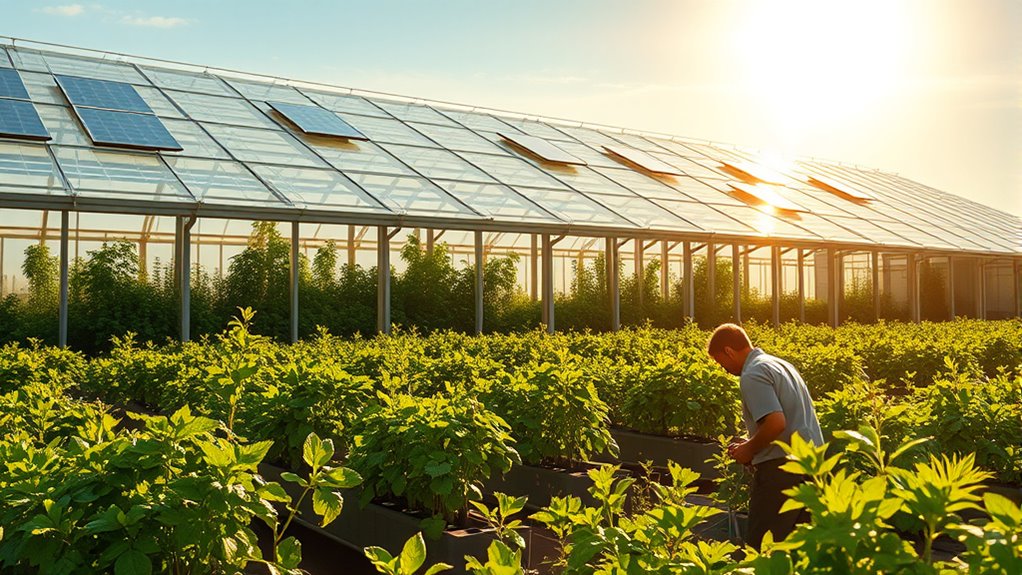
As advancements in technology continue to reshape the agricultural landscape, the future prospects for solar greenhouses look increasingly promising.
You can expect significant leaps in solar panel efficiency and energy storage systems, allowing for consistent power management. Innovations like semitransparent solar cells will enable you to harness more light while maintaining optimal growing conditions.
Smart technologies will provide real-time monitoring, enhancing productivity. The market’s growth suggests job creation and strategic partnerships that foster further innovation.
As countries with abundant sunlight adopt these greenhouses, you’ll see reduced carbon footprints and improved water conservation.
Government Incentives for Solar Adoption
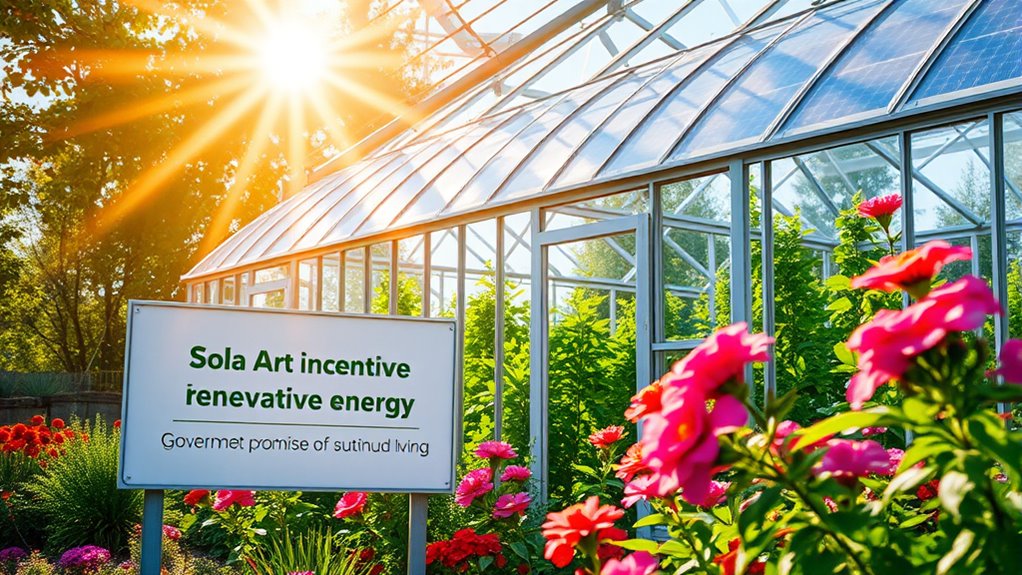
While many barriers to solar energy adoption exist, government incentives play a crucial role in making solar power more accessible and affordable.
You can benefit from the Federal Investment Tax Credit (ITC), which offers a tax credit of up to 30% on your solar installation costs through 2032. Depending on where you live, state-level incentives may include rebates and tax credits that can further reduce expenses.
Programs like net metering let you earn credits for excess energy you generate. Additionally, low-interest loans and solar renewable energy certificates (SRECs) can enhance your financial flexibility.
These incentives not only make solar energy more feasible for you but also contribute to job creation and a cleaner environment.
Customizing Your Solar-Powered Greenhouse
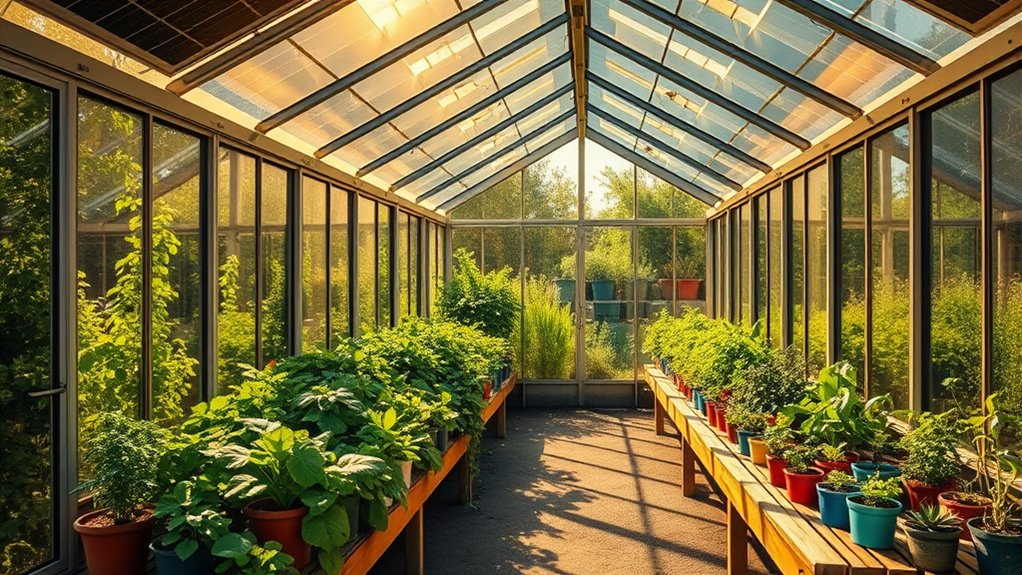
Customizing your solar-powered greenhouse can significantly enhance its functionality and aesthetic appeal, ensuring it meets your specific gardening needs.
Start by orienting your greenhouse south for maximum sunlight exposure. Choose polycarbonate or double-glazed glass for effective insulation and light retention. Incorporate thermal mass solutions like water barrels to store heat and release it overnight.
Utilize solar panels to power ventilation systems and lights, while batteries store excess energy for cloudy days. Design flexible shelving and automated irrigation systems to optimize space and maintain consistent watering.
Consider integrating aquaponics for a sustainable ecosystem. Lastly, adapt your greenhouse for regional climate conditions by adding insulation or effective ventilation to ensure your plants thrive year-round.
Frequently Asked Questions
What Types of Crops Grow Best in Solar-Powered Greenhouses?
If you’re looking to grow crops in a solar-powered greenhouse, consider leafy greens like lettuce and kale, as they thrive in controlled environments.
Fruiting crops such as tomatoes and cucumbers also do well, along with herbs like basil and mint.
Don’t forget about microgreens; they flourish under stable conditions.
Lastly, various flowers can add beauty and diversity to your greenhouse.
With optimal light and temperature, you’ll see great results!
How Long Do Solar Panels Last in a Greenhouse Setting?
Solar panels generally last about 25 to 30 years, regardless of where you install them.
Their lifespan depends on factors like the panel’s quality and the environmental conditions they face.
You’ll find that high-quality panels from reputable brands degrade slower, retaining 80-90% of their output after 25 years.
Regular maintenance, such as cleaning and inspections, can also help extend their operational life, ensuring you get the most out of your investment.
Can Solar-Powered Greenhouses Operate During Cloudy Weather?
Yes, solar-powered greenhouses can operate during cloudy weather.
While solar panels produce less energy—typically 10-25% of their normal output—you can still harness enough electricity to support essential systems.
Modern panels capture diffuse light effectively, and bifacial designs enhance efficiency further.
It’s crucial to have good insulation and possibly energy storage solutions to stabilize your power supply.
With the right setup, your greenhouse can thrive, even on overcast days.
What Is the Average Payback Period for Solar Greenhouse Investments?
The average payback period for solar investments typically ranges from 7 to 10 years, but it can vary depending on your location and available incentives.
In some areas, like Maryland, it might stretch to 12 years, while in places like Ohio, it could go up to 16 years.
Keep in mind that utility rates, system size, and local incentives will all play significant roles in determining your specific payback period.
Are There Grants Available for Building Solar-Powered Greenhouses?
You might think finding grants for solar-powered greenhouses is like searching for unicorns!
But don’t worry, there are options available. While specific grants for solar greenhouses are rare, you can tap into renewable energy grants, agricultural funding, or programs like Solar for All.
Just make sure your project shines with community benefits and sustainability. Prepare a strong proposal, and you’re on your way to securing the funds you need!
Conclusion
Incorporating solar power into your greenhouse isn’t just a trend; it’s a sustainable revolution blooming at your fingertips. By harnessing the sun’s golden rays, you can cultivate healthier crops while nurturing the planet. Though challenges may arise, the benefits far outweigh them, paving the way for a greener future. As you embark on this eco-friendly journey, remember that every solar panel is a seed planted for tomorrow’s harvest—one that promises energy efficiency and flourishing yields.


